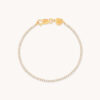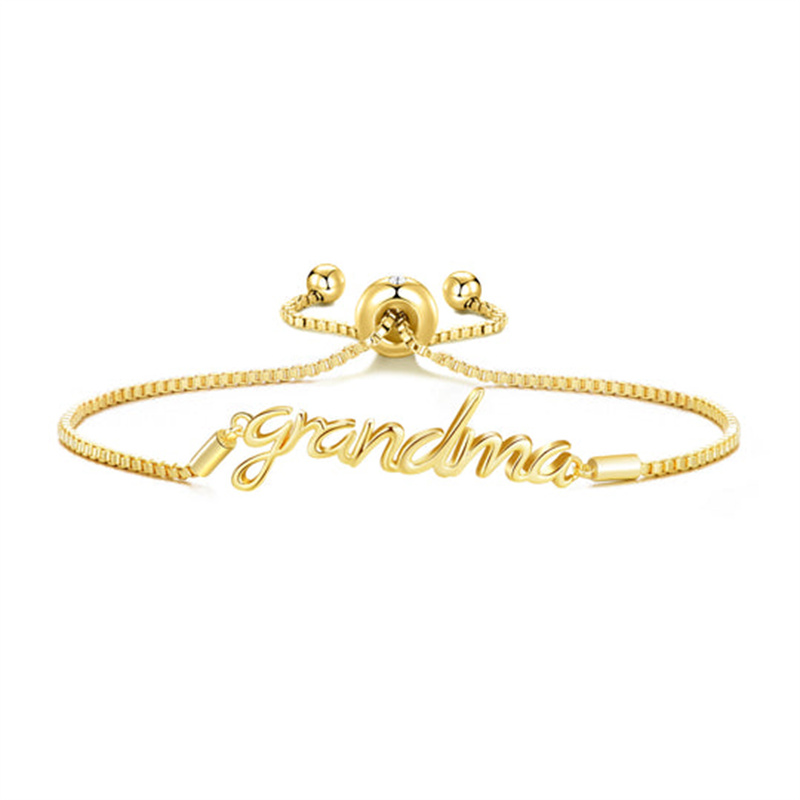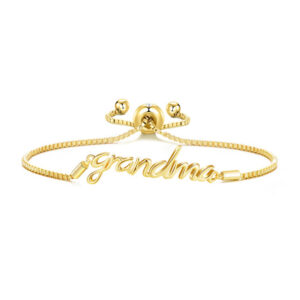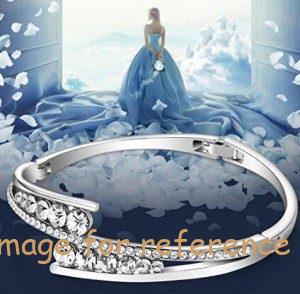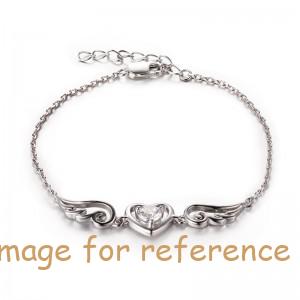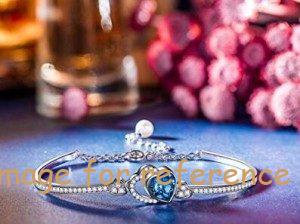Nhớ:Nhà sản xuất đồ trang sức Letter Bracelet mạ vàng OEM ODM
Nhà sản xuất trang sức OEM/ODM Thiết kế tùy chỉnh đồ trang sức của riêng bạn
Hãy để bắt đầu : mo@kingjy.com
Nhớ: Nghệ thuật cá nhân hóa – An OEM/ODM Gold Plated Letter Bracelet Manufacturing Journey
In the vibrant and ever-evolving landscape of fashion jewelry, few items possess the unique power of the letter bracelet. It is a piece that transcends mere adornment, becoming a canvas for identity, sự liên quan, and personal narrative. Whether it spells out a name, a meaningful word, an initial, or a secret message, it carries a story on the wrist. For brands looking to capitalize on this profound trend, the journey from a spark of an idea to a shelf-ready product is expertly facilitated by a specialized OEM/ODM jewelry manufacturer.
The Chinese term “Nhớ” (việc kinh doanh) embodies the concepts of operation, sự quản lý, and meticulous cultivation. MỘT “Nhớ” manufacturer does not merely assemble products; it cultivates partnerships, manages complex supply chains, and operates with a philosophy of continuous improvement and client-centric service. Bài viết này sẽ cung cấp một cách đầy đủ, behind-the-scenes exploration of the OEM (Nhà sản xuất thiết bị gốc) và ODM (Nhà sản xuất thiết kế ban đầu) processes for creating a custom gold-plated letter bracelet. We will dissect every stage, from the initial concept to the final packaged product, revealing the intricate blend of technology, nghệ thuật, and strategic management that defines this manufacturing niche.
Giai đoạn 1: Nền tảng – OEM vs. ODM and the Initial Partnership
Understanding the distinction between OEM and ODM is crucial, as it defines the nature of the client-manufacturer relationship from the outset.
OEM (Sản xuất thiết bị gốc): The Client’s Blueprint
Trong một mô hình OEM, the client comes to the manufacturer with a fully or largely developed design. They provide detailed specifications, bản vẽ kỹ thuật, or even a physical sample. The manufacturer’s role is to execute this design precisely, sourcing materials and managing production according to the client’s explicit instructions. For a letter bracelet, this could mean a brand providing the exact font file for the letters, the precise dimensions of the chain links, and the specific type of gold plating required.
ODM (Thiết kế ban đầu sản xuất): The Manufacturer’s Innovation
Trong một mô hình ODM, the client leverages the manufacturer’s existing design expertise, R&D capabilities, and product libraries. A brand might approach the manufacturer with a market need—”we want a line of trendy, dainty letter bracelets for young adults”—and the manufacturer will present a range of pre-designed options for customization. The client can then select a base model, modify it (VÍ DỤ., change the chain style, the font of the letters, or the clasp), and brand it as their own. This is a far more collaborative and efficient model for clients who may not have in-house design resources.
Bước chân 1: Tư vấn ban đầu & Project Scoping
The process begins with a deep-dive conversation to align vision with feasibility.
-
Client Vision: Is the client an OEM partner with rigid specifications, or an ODM partner seeking creative input?
-
Bracelet Style: Những cân nhắc chính bao gồm:
-
Letter Form: Are the letters individual charms hanging from a chain? Are they interconnected links that form a word? Are they stamped onto a flat bar?
-
Loại chuỗi: A delicate cable chain, a sturdy rope chain, a trendy snake chain, or a box chain? The choice impacts the bracelet’s style, độ bền, và cảm nhận.
-
Cơ chế clasp: A simple spring ring clasp, a secure lobster clasp, a decorative toggle clasp, or a sophisticated box clasp with a safety latch?
-
-
Thông số vật liệu:
-
Kim loại cơ bản: This is the core material that will be plated. The most common choices are:
-
Thau: The industry standard for gold-plated jewelry. It’s affordable, bền, and takes plating exceptionally well.
-
Đồng: Also an excellent base for plating, offering a very smooth surface, but softer than brass.
-
Thép không gỉ: Một phí bảo hiểm, Hypoallergenic, and extremely durable base. Gold plating over stainless steel (often called gold IP, or Ion Plating) is more wear-resistant but also more expensive.
-
-
Đặc điểm kỹ thuật mạ: The type and quality of the gold layer.
-
Độ dày mạ: Đo bằng micron (VÍ DỤ., 0.5 micron, 1 Micron, 3 micron). A thicker plating lasts longer and is more resistant to tarnishing. The industry often refers to this as “Heavy Gold Plating.”
-
Plating Color: Vàng vàng, vàng hồng (một hợp kim vàng và đồng), or white gold (an alloy of gold plated with rhodium for a bright white finish).
-
Loại mạ: Standard electroplating is common. For higher-end pieces, IP (Mạ ion) or PVD (Lắng đọng hơi vật lý) create a more bonded, bền, and scratch-resistant surface.
-
-
-
Khối lượng đặt hàng & Target Price: The manufacturer must understand the budget and quantity, as this dictates the manufacturing techniques. A order of 50,000 units allows for different tooling and processes than a custom order of 500 mảnh.
Giai đoạn 2: The Design and Engineering Blueprint
This phase transforms the conceptual into the technical.
Bước chân 2: Thiết kế hoàn thiện & Mô hình CAD
Whether working from a client’s OEM design or developing an ODM concept, the process culminates in a precise digital model.
-
Font Selection & Vectorization: For letter bracelets, typography is everything. The design team either uses the client’s provided font file or selects an appropriate one from their library (ensuring licensing compliance). Each letter is converted into a clean, manufacturable vector path.
-
3Mô hình CAD D: Using specialized jewelry CAD software (like Rhino Gold or Matrix), a designer creates a three-dimensional model of the entire bracelet.
-
Letter Geometry: The model defines the thickness, depth, and any decorative bevels or edges on the letters.
-
Xích & Link Engineering: Each link of the chain is modeled to ensure smooth movement and structural integrity. For interconnected letter bracelets, the connection points between each letter are engineered to be both flexible and strong.
-
Clasp Integration: The clasp is modeled and integrated seamlessly into the bracelet’s design.
-
-
Virtual Prototyping & Rendering: The CAD model allows for virtual assembly and photorealistic rendering. The client can see the bracelet from all angles, in different gold colors, and often in a “virtual try-on” kịch bản. This is the stage for final approvals and adjustments before any physical cost is incurred.
Bước chân 3: Trích dẫn & Project Finalization
Với mô hình CAD đã hoàn thiện, the factory can generate an accurate and detailed quotation.
-
Phân tích chi phí:
-
Base Metal Cost: Calculated from the volume of the CAD model.
-
Chi phí mạ: Based on the surface area and the specified plating thickness and type.
-
Chi phí dụng cụ/khuôn mẫu: The one-time cost for creating casting molds or stamping dies.
-
Chi phí lao động: Encompassing sampling, đúc, cuộc họp, đánh bóng, mạ, và kiểm soát chất lượng.
-
Chi phí đóng gói.
-
-
Timeline Agreement: A production schedule is established, outlining key milestones from sampling to final delivery.
-
Contract Signing: A formal agreement is signed, khóa trong tất cả các thông số kỹ thuật, chi phí, mốc thời gian, and terms of quality.
Giai đoạn 3: The Prototyping Stage – A Physical Reality
Bước chân 4: Sample Making – Các “First Article”
A physical sample is created to validate the design, cảm thấy, và chất lượng.
-
3D in (Tạo mẫu nhanh): Tệp CAD được gửi đến máy in 3D có độ phân giải cao, which creates a resin model of the bracelet. This is a fast and accurate way to check the form, the font clarity, and the overall proportions.
-
Đúc mẫu & Cuộc họp: The resin model is used to create a master mold, and a small batch of samples is cast in the specified base metal (VÍ DỤ., thau). These samples are then hand-finished, assembled, and plated to the agreed standard.
-
Các “Gold Sample”: This finished sample, mirroring the final production piece, is sent to the client for approval.
Bước chân 5: Đánh giá mẫu & Sự chấp thuận
The client conducts a rigorous evaluation of the sample:
-
Độ trung thực của thiết kế: Does the font look correct? Is the size and proportion as expected?
-
Thoải mái và khả năng đeo: How does it feel on the wrist? Is the clasp easy to operate?
-
Finish and Plating Quality: Is the color of the gold plating correct? Is the surface smooth and brilliant?
-
Durability Check: Are the connection points secure? Does the chain feel strong?
Client feedback is incorporated, và nếu cần thiết, a second pre-production sample is made until full approval is granted.
Giai đoạn 4: Sản xuất hàng loạt – The Symphony of Craftsmanship
Với mẫu đã được phê duyệt, nhà máy chuyển sang sản xuất toàn diện.
Bước chân 6: Dụng cụ & Component Manufacturing
The method of manufacturing depends on the design complexity and order volume.
-
Đúc (Đối với các thiết kế phức tạp): The most common method for detailed letter charms and complex chain links.
-
Làm khuôn: A master metal model is created from the approved sample. This master is used to create rubber molds.
-
Wax Tree Injection & Sự đầu tư: Wax replicas are injected into the molds and assembled onto a “cây.” The tree is then placed in a flask and surrounded by a plaster investment.
-
Kiệt sức & Đúc: Bình được làm nóng, melting the wax away (các “sáp bị mất” phương pháp). Molten brass is then centrifugal-cast into the hollow cavities.
-
Giá trị: Sau khi được làm mát, the plaster is broken away, revealing a tree of raw brass bracelet components.
-
-
Dập (for simpler, flatter designs): For basic letter charms or bar bracelets, metal stamping dies are created. A powerful press stamps the letters out of a sheet of brass, which is a very fast and cost-effective method for high volumes.
Bước chân 7: Pre-Assembly Finishing
The raw cast or stamped components are rough and require extensive cleaning and finishing.
-
Khử mầm: The cast components are carefully cut from the casting tree.
-
Tumbling/Vibratory Finishing: The components are placed in large tumbling machines with abrasive media, Nước, and compound. Quá trình này, có thể kéo dài hàng giờ, removes casting imperfections, smooths edges, and work-hardens the metal, giving it a preliminary shine.
Bước chân 8: Cuộc họp & Hàn
This is a critical stage where the bracelet takes its final form.
-
Chain Assembly: For charm bracelets, the letters and other charms are linked onto the pre-made chain. For interconnected letter bracelets, each letter is meticulously linked to the next by a skilled assembler, often using micro-tweezers under magnification.
-
Hàn: Any permanent connections, such as attaching jump rings that are meant to be closed or fixing the clasp to the chain ends, are done through soldering. A jeweler uses a small torch and solder to create a strong, seamless bond. This requires great skill to avoid melting the delicate components or discoloring the metal.
Bước chân 9: Đánh bóng & Tinh chỉnh bề mặt
To achieve a flawless surface for plating, the assembled bracelets undergo meticulous polishing.
-
Mechanical Polishing: The bracelets are polished on motorized wheels with various types of brushes and polishing compounds (Rouge). This step brings out a high-gloss, mirror-like shine on the brass.
-
Đánh bóng tay: For intricate areas around the letters and chain links that machines cannot reach, experienced polishers perform detailed hand-polishing.
Bước chân 10: Mạ điện – Sự chuyển đổi vàng
This is the step that gives the bracelet its luxurious final appearance.
-
Làm sạch siêu âm: The polished bracelets are thoroughly cleaned to remove all traces of polishing compound, oil, and dust. Any contamination will cause plating failure.
-
Làm sạch bằng điện: The bracelets are submerged in an electrochemical bath to ensure a perfectly pristine surface at a microscopic level.
-
Rửa sạch: Multiple rinses in deionized water remove all cleaning solutions.
-
Bồn tắm mạ: The bracelets are immersed in the gold plating solution (electrolyte). They are connected to the cathode (negative terminal) của một bộ chỉnh lưu, while a pure gold anode (positive terminal) cũng được cho vào dung dịch.
-
Áp dụng hiện tại: Một dòng điện được truyền qua dung dịch, causing gold ions to dissolve from the anode and bond uniformly to the surface of the bracelet (cực âm).
-
Process Control: The thickness of the plating is precisely controlled by the duration of the immersion and the amperage of the current. Đối với một “heavy gold plating,” the bracelet remains in the bath for a longer period.
-
Nước rửa sau mạ & Neutralization: Sau khi mạ, the bracelets are rinsed again and often treated in a neutralization bath to stabilize the plating layer.
-
Optional Top Coat: For increased tarnish resistance, a clear, lớp phủ bảo vệ chống xỉn màu (like EPXY) may be applied.
Giai đoạn 5: The Final Countdown – Chất lượng, Thương hiệu, và giao hàng
MỘT “Nhớ” manufacturer distinguishes itself through an uncompromising quality control regime.
Bước chân 11: Rigorous Quality Assurance
Every single bracelet is inspected against a multi-point checklist:
-
Chất lượng mạ: Kiểm tra tính nhất quán của màu sắc, phạm vi bảo hiểm (no missed spots), and absence of peeling, sủi bọt, hoặc đổi màu.
-
Surface Defects: Inspection for scratches, hố, or polishing marks that were missed.
-
Tính toàn vẹn cấu trúc: Tug-testing the chain and connections to ensure they are secure. Checking that soldered points are smooth and strong.
-
Chức năng khóa: Testing the clasp repeatedly to ensure it opens, closes, and locks reliably.
-
Kích thước & Spelling Check: Verifying the length and, most critically, ensuring the letters are correct and the word is spelled properly—a non-negotiable step for a letter bracelet.
Bước chân 12: Khắc laser & Thương hiệu
This is where the client’s brand identity is permanently etched onto the product.
-
Brand Logo/Name: The client’s logo or brand name is laser-engraved onto the clasp or a discrete part of the bracelet.
-
Material Marking: Hallmarks like “bác sĩ gia đình” (Vàng mạ) or the base metal (VÍ DỤ., “Thau”) can be added.
Bước chân 13: Làm sạch cuối cùng & Bao bì
The approved bracelets undergo a final ultrasonic clean and steam blast to remove any fingerprints or dust from the QC process. They are then carefully placed in their individual packaging—be it a branded polybag, một túi nhung, or a custom-printed gift box, ready for the retail environment.
Bước chân 14: Hậu cần & Hỗ trợ sau bán hàng
The factory manages the final leg of the journey: efficient packing, customs documentation, and shipping via the agreed-upon method. A reliable manufacturer also provides after-sales support, handling any inquiries and facilitating smooth re-orders.
Phần kết luận: The Cultivation of Meaning
The journey of a gold-plated letter bracelet from a concept to a consumer’s wrist is a profound example of modern manufacturing “JINGYING.” It is a process meticulously managed and cultivated, blending digital precision with artisanal skill. Cho một thương hiệu, whether engaging in OEM or ODM, this partnership is strategic. It provides access to sophisticated manufacturing capabilities, kiểm soát chất lượng nghiêm ngặt, and scalable production, all while allowing the brand to focus on its core competency: marketing and storytelling.
The final product is more than just gold-plated brass; it is a vessel of personal identity. It represents a successful collaboration, a managed process, and a tangible piece of a brand’s promise to its customers. Trong thế giới trang sức cá nhân, các “Nhớ” manufacturer is the silent, expert partner that makes meaningful connection possible, one letter at a time.


